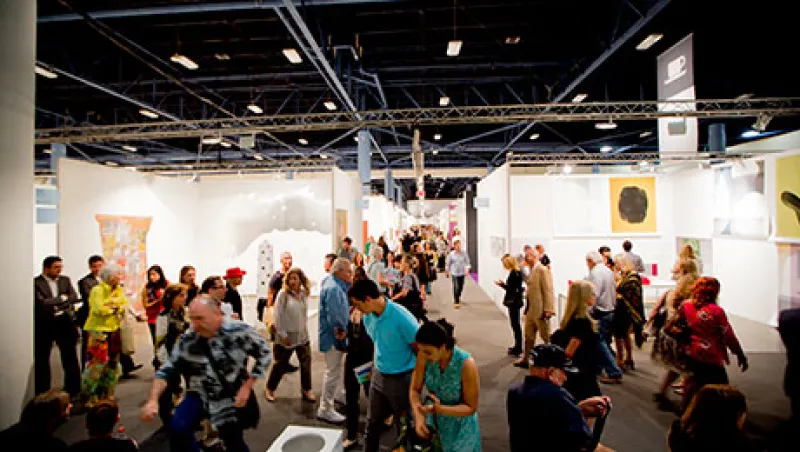From December 4 through 7, tens of thousands of art lovers and collectors will descend on Miami Beach for its annual Art Basel festival. With such a concentration of private money gathering in one place for this global showcase of contemporary art, it’s no surprise that financial services firms would have a presence.
But every year more representatives of banks and asset managers join the crowd, making Art Basel Miami Beach one of the hottest tickets in the wealth management business. All of this schmoozing reflects Miami’s swift transformation from resort town to melting pot of international capital.
Tony Baumer, a managing director with J.P. Morgan Private Bank in Miami, has seen an influx of wealth from Europe, Latin America and other parts of the U.S. in recent years that coincides with the city’s expanding cultural footprint. “There is no question that Basel signifies the strides that Miami has taken in becoming a destination for client families with complex needs that often span multiple geographies,” he says.
John Mathews, head of private wealth management for the Americas with Swiss bank UBS, has attended the Miami get-together since 2002. “Art has become a very important part of our ultra-high-net-worth clients’ assets,” he says. “I don’t think there has been a better time to be in the advice business, and our clients need guidance in the art world due to the increasing complexity.”
The average wealthy person allocates about 9 percent of his or her portfolio to art and collectibles, according to a 2014 survey of some 250 private banks, family offices, art collectors and art professionals by Deloitte Luxembourg, a division of the consulting giant, and London-based market research firm ArtTactic. The latest installment of the annual study also found that 76 percent of art collectors take an investment view of their purchases, versus 53 percent in 2012. These trends mirror the big upswing in valuations for contemporary art during the past few decades.
UBS’s history with Art Basel Miami Beach’s parent festival in Switzerland dates back more than 20 years. During that time Art Basel has become a worldwide phenomenon, Mathews notes, allowing his group to rub shoulders with clients and prospects from nearly every nation in which the bank does business.
A primary sponsor of the Miami gathering, UBS is uniquely positioned to give advice on the contemporary art market. The bank’s collection numbers more than 30,000 paintings, prints, photographs and sculptures that date from roughly 1960 to the present, representing its own acquisitions and those of firms that have merged with UBS, most notably PaineWebber Group.
“The works of art in the collection form an important part of UBS’s corporate identity and contribute to a rewarding experience for clients and employees alike,” says Jacqueline Lewis, the UBS Art Collection’s director and regional curator for the Americas. In Miami, Lewis will lead tours and educational programs on behalf of UBS; she’s also overseeing the display of pieces from the bank’s collection, including works by high-profile artists John Baldessari, Walead Beshty and Anne Collier.
Once mostly viewed as a vacation spot and a U.S. outpost for Latin American banks, Miami has rapidly come into its own as a financial hub. Today its downtown is flush with asset management firms ranging from multifamily offices to private banks.
“Miami has simultaneously been elevated into an international cultural center and destination — a place where sophisticated capital gravitates,” says Nitin Motwani, a managing director with local private equity firm Encore Capital Management, which oversees more than $1 billion in assets, and a board member of the Miami Downtown Development Authority (DDA). “In many ways the Miami Art Basel event defines this transformation.”
The DDA has pushed to attract financial firms and technology companies to the city, where the perks include no state income tax and growing access to local capital. The move by hedge fund firm Universa from Santa Monica, California, to Miami this February was a coup, coming two years after founder Edward Lampert’s decision to move ESL Investments’ headquarters there from Connecticut.
These moves make sense, given that family offices have been drawn to open Miami locations in pursuit of investment opportunities as much as beautiful weather, notes Motwani, whose firm focuses on private real estate investments.
J.P. Morgan’s Baumer, whose group hosted a private party with Pittsburgh’s Warhol Museum in the lead-up to Art Basel Miami Beach, has seen client interest in the festival grow as art and finance become increasingly intertwined. Even inside major banks, art-based lending — the extension of credit with artworks as collateral — is a prime example of the services unique to specialized groups such as Baumer’s.
This year marks the 55th anniversary of former Chase National Bank CEO David Rockefeller’s initiative to install art in regional offices, the genesis of today’s JPMorgan Chase Art Collection. Lisa Erf, the collection’s director and curator, advises bank clients on art holdings. Having watched Miami’s Art Basel blossom into a vibrant event that allows JPMorgan Chase & Co. to mix business with pleasure by hosting the global elite, she says the firm’s core vision for art and investment remains unchanged: “Since the collection began, the first and primary focus has been to be good stewards of the art that we have acquired, just as we strive to help our clients be good stewards of wealth for future generations.”






